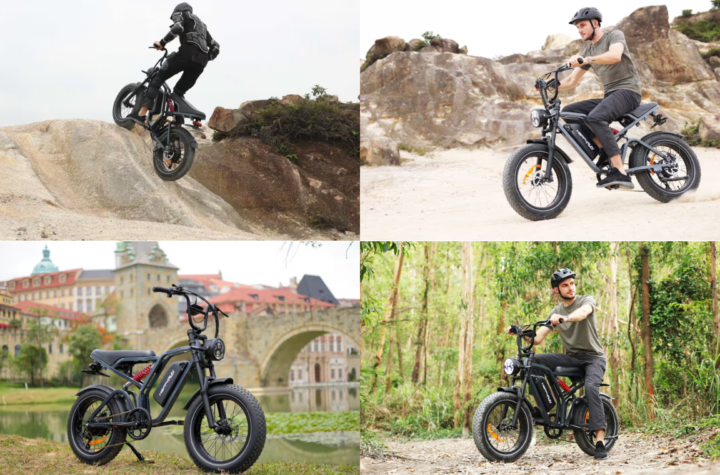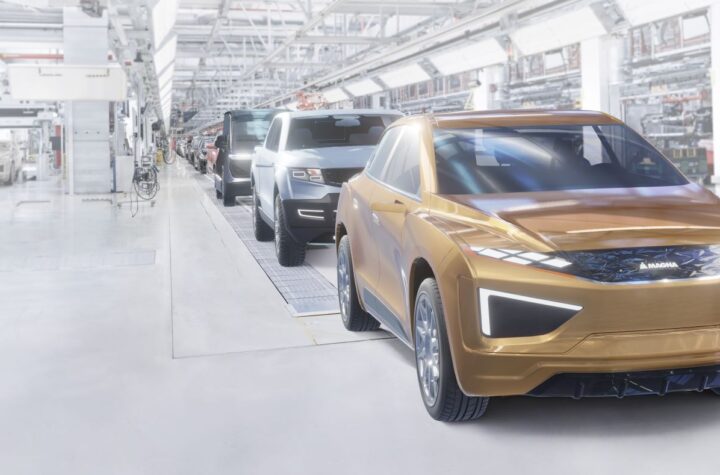
The Yacht-club set gets an upscale Armada, dressed in Infiniti clothing.
 |
| The Infiniti QX56 has unique front sheet metal and liftgate outer. The molding on the lower portion of the doors give them a look of their own. The interior is both flexible and elegant. |
Larry Dominique, chief product specialist for Infiniti and Nissan says that research shows that the segment has grown 444 percent from 1992 through 2002 and is estimated to grow by another 72 percent from 2002 to 2008.
Dominique says that in the last two years alone the segment has grown by about 256,000 units or 38 percent and if Infiniti is right in stating that the average income for a full-size luxury SUV owner is $350,000 a year, then it’s no surprise that they want to play there.
Infiniti needs to capture a 15.1 percent share of the market against direct competitors, like Lincoln Navigator, Cadillac Escalade, Lexus GX470 and Range Rover to achieve its planned objective of 15,000 units. While pricing had not been announced at this time, the MSRP is estimated to be in the $50,000 range.
Living Large
Infiniti describes the QX56 as “massive precision,” and massive it is. The 5500-lb. truck sits on a 123-in. wheelbase with a total length of 206.9 in., one inch longer than the Lincoln Navigator. It stands 78 in. wide and 77.8 in. tall (2WD) or 78.7 in. tall (AWD).
The backbone of this product is the FAlpha platform that it shares with the Nissan Pathfinder Armada. It features a fully-boxed Tower-supplied frame with an independent double wishbone front suspension and a unique independent rear suspension with the coil spring separated from the shock.
“The way those two devices work, the springs and the shocks,” says Dominique, they need to have different mounting angles to be optimized.
QX56 shares the Armada’s all-mode allwheel- drive system. At start the system splits torque 50-50 between the front and rear wheels. At cruising speed all torque is transferred to the rear wheels though the system constantly monitors torque while driving and can vary torque front to back as needed. The system when linked with Active Brake Limited Slip (ABLS) can apply torque to any wheel that has traction.
QX56 comes standard with Vehicle Dynamic Control and ABLS. Dominique says that on the SUVs with the independent rear suspension, the rear differential is done inhouse. The front and rear half shafts, prop shaft and front transaxle are all supplied by Dana. The suspension on the Infiniti is tuned specifically for the target buyer.
Dominique says that their research showed that women drive these vehicles more than men do and one of the most disconcerting issues that they have with full-size SUVs is that they don’t feel confident driving them. “We wanted to make sure that our full-size SUVs didn’t drive and feel like historical fullsize SUVs,” Dominique says.
The vehicle exhibits virtually no body roll, something that was tuned out without using electronics.
“The trade-off,” says Dominique, “is that you’re always fighting the harshness of the ride.” Dominique says that a lot of time was spent on suspension tuning and believes that they have achieved the best balance they can get. The QX56 suspension is firm but can be a little harsh at times, picking up irregularities in the road and transferring the vibrations up through the seat. The ride was especially harsh over a short stretch of washboard road.
It’s What’s Inside
 |
The same interior suppliers outfit both the Armada and QX56, though the QX gets a different center stack and while the vehicles share seat frames, the exterior styling is unique. |
 |
An electronic air leveling system ties into a standard airbag suspension.
The exhaust system has been designed with less back pressure for a quieter exhaust note.
The engine is mated to a 5-speed automatic transmission, the only transmission available on the QX56. The shifts are very quick and very smooth. Dominique says that the BMW X5 was benchmarked for its shift characteristics. Every QX56 is set up for towing with a towing capacity of 8,900 lbs. The final drive ration is 3.357:1 which Dominique says is about equivalent to a 4:10 rear end on competitor’s vehicles with a 4-speed automatic.
QX56 has a fold-flat rear seat, fold-flat second row and a fold-flat passenger front seat enabling the owner to load cargo over 10 feet long while still able to shut the rear hatch. Total interior volume is 188.4 cu.-ft., with 97.1 cu.-ft. of cargo space behind the second row.
Infiniti describes the QX56 interior as stylish, progressive and athletic, trimmed in real brushed aluminum, real wood trim and Infinitionly Sojourner leather seats. Front seat head room is 41-in. and leg room is 41.8 in.. The second row seats are an inch higher and the third row sits 2.75 in. higher than the first row.
Dominique says that this was the result of lessons learned with the Xterra where they found that a lot of rear-seat passengers felt claustrophobic. The first- and second-row seats are heated. QX56 comes standard with second-row buckets and a removable center console. An optional second-row bench seat is available at no extra charge. Both second and third rows feature storage bins and cupholders.
Standard interior features include a DVDbased navigation system, 10-way power driver’s seat and 8-way power front passenger seat, reclining rear seats, power adjustable pedals and Bose in-dash 6-disc CD changer with 10 speakers.
The steering wheel powers up-and-down but doesn’t telescope. All QX56s come with a power lift gate and rear proximity sensors. There is also an optional rear view monitor with a camera mounted in the lift gate handle.
Activated when the vehicle is put into reverse, the camera is primarily focused on the hitch ball, allowing for easy line-up with a trailer.
 Options include a DVD entertainment system, and intelligent cruise control. All QX56s are pre-wired at the factory for either XM or Sirius satellite radio, installed at the dealer. The QX56 has an advanced air bag system featuring dual-stage front supplemental air bags with seat belt sensors and front passenger occupant classification sensors. There are also standard front side-impact seat-mounted air bags.
Options include a DVD entertainment system, and intelligent cruise control. All QX56s are pre-wired at the factory for either XM or Sirius satellite radio, installed at the dealer. The QX56 has an advanced air bag system featuring dual-stage front supplemental air bags with seat belt sensors and front passenger occupant classification sensors. There are also standard front side-impact seat-mounted air bags.Side curtain air bags for all three rows are tied in to an anti rollover system that uses sensors to analyze the vehicle roll rate and roll angle to determine if the vehicle is at or near a rollover condition. In the event of a rollover or near rollover the curtain and seatbelt pretensioners will deploy. The bags will stay inflated for up to six seconds. The system, a joint development with Autoliv, uses two side curtain bags, one for the first and second row and another for the third row.
QX56 comes standard with ABS and brake assist, Electronic Brake force Distribution (EBD) Vehicle Dynamic Control and a direct tire pressure monitoring system with a sensor mounted in each wheel for accurate readings.
Nissan spent a lot of time and money developing the NVH performance on this vehicle, such as adding 70 lbs. of sound deadening material. Dominique says that the material isn’t thicker but of a higher density.
For instance, the front dash mat on the Armada is an R35 while the front dash mat on the QX56 is an R75. Higher density padding was also added in front of the front and rear wheel wells. Both Armada and QX56 have triple door seals and thicker glass. The windshield is 5.3 mm, side windows are 5 mm and the second and third row glass is 4 mm thick.
Share and Share Alike
The QX56 shares sheet metal with Armada from the A-Pillar back with the exception of the lift gate outer. The all-steel front end features a waterfall-style chrome grille and unique front and rear fascias.
 |
| The QX56 uses a version of the North American-built 5.6L V-8, though the Infiniti version has been remapped for premium fuel, an Infiniti mandate. |
Body side cladding gives the doors a distinctive look. Dominique says that the cladding is very thin, the goal being to make it look like part of the vehicle and not an add-on. Chrome 18-in. wheels are mounted on P265 70R18 Continental tires.
Armada and QX56 share about 60 percent of the main IP pad but the center stack is unique to QX56. Basic seat structures are the same but the QX56 seats have unique foam shapes, materials and seat patterns. The same suppliers are used for both the Nissan and Infiniti interiors. Johnson Controls supplies the seats, Lextron, a joint venture with Visteon supplies the IP, lower interior trim comes from Emtech. and the overhead consoles are supplied by Lear. QX56 has standard Xenon headlamps and LED taillamps.
Three Amigos
Dominique says that all three vehicles, Titan, Armada and QX56, were developed simultaneously. “Three years ago we were driving prototypes of the frame systems.
“When we started developing Armada,” Dominique continues, “we took the suspension to a certain level of performance.
“We actually turned some of the Armada vehicles into QX56s from a platform development standpoint swapping out the suspension, and tires and getting it to the right NVH level.”
The QX56 is the first Infiniti to be built in North America at Nissan’s Canton, Miss., assembly plant. The 15,000 units will be included in the 60,000 full-size SUVs scheduled for yearly production. Additonal body protectors have been added to the Infinitis to reduce the chance of paint chips and scratches. They will also get an extra clear coat for exta protection. Special quality checkpoints have been added to inspect the QX56s which will not be batch-buit but run in sequence with the Nissan Armada and Titan pickup. While no new workers have been added, selected quality-control workers have been trained on how to pay special attention to the Infiniti products.
Mark Igo, vice president and general manager for Infiniti sees a great significance in building Infinitis in North America.
“This gives us tremendous flexibility in the future to expand out lineup in the North American market,” Igo says. “Having U.S. built product is a very positive thing.”
Dominique says that they ran 15 units just before Christmas to try out the final production systems and to check the quality systems.
Dominique made some changes to the vehicle specification about three months ago, changing the headrests to eliminate a seam and adding an embroidered Infiniti logo to the second row seats.
“What I want to do is continue to push the envelope for the luxury feel of the vehicle,” Dominique says. “It’s a little thing, but there was actually a seam in the headrest that I didn’t like, so I talked to styling and the parts manufacturing people and we ended up going to a slightly different foam in the headrest and eliminated that seam. It just makes it look a little more integrated with the vehicle.”
Production started on January 19. While the Canton, Miss., assembly plant has plenty of flexibility within the full-size mix of King and Crew Cab Titans, Armada and QX56, where will the extra capacity come from if the fullsize Infiniti exceeds expectations?
“The biggest issue right now,” says Dominic, “is that Titan had a good month last month (December 2003). We sold 200 percent better than we thought we could sell. This month its doing extremely well also.” Dominic says that obviously, if sales justify the need, Nissan is always looking for ways to produce more.
“Nissan does studies to determine what would be needed to increase production past the allotment,” Dominic says. “We’re studying ways that we could go 20 or 30,000 units more or 50,000 units more.”
Dominic says that the plant could produce 5 to 10 percent more just through pure overtime and weekend work, “but you don’t like to do that to your employees long term. So, certainly, as you study what else you could do with these vehicles, whether it’s a V-6 in a Titan or a long wheelbase or, potentially, heavy duty, you’re studying everything all the time and obviously manufacturing has to be involved in the discussion.”













More Stories
From Gasoline Powered Cars To Electric Vehicles | Electric Moped Bike A Best Alternative
Rubbernecking: A Silly Reason for Car Accidents
Flexible Magna Manufacturing Solutions: The Key to Success in the Automotive Industry